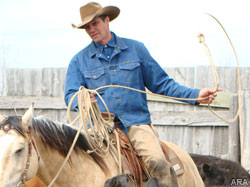
(ARA) – When your office is the open range and your commute is on horseback, like mine is, it’s easy to imagine life in the Old West when schedules were set by the sun and blackberries were something you picked off the vine. Aside from a few modern conveniences, some people might be surprised to learn that life is not much different today than it was when our ancestors roamed the plains – especially our commitment to the care and handling of our animals.
In fact, many of the families who raise cattle in this country have been raising livestock for decades, with each succeeding generation accepting the legacy of good stockmanship. The commitment to raising animals humanely and caring for them is a family tradition that has been handed down and improved upon from generation to generation. It’s no surprise to me that the number of cattle farms and ranches in this country that are family-run hovers around 97 percent. The truth is American beef comes from American families, just like mine and yours.
Located in all 50 states, these families who bring beef from pasture to plate are also in the business of caring for animals. We know that quality beef begins with quality animal care, which is why we work hard to keep our animals healthy, safe and secure. There are approximately 750,000 American beef farmers and ranchers whose livelihoods depend on treating animals humanely to produce a safe and wholesome product. We take proper care of our cattle because when we do, they take care of us and our families.
For example, one of the ways we ensure the comfort of the animal is handling cattle to minimize stress and to assure safety of both cattle and handlers. Ranchers strive to improve cattle handling performance by trying to understand animal perception. Some of the rules my beef industry colleagues and I live by are:
1. Never think of the relationship with the animal as a “predator/prey” relationship, but rather a relationship of comfort.
2. Patience is a virtue – stay calm.
3. Always work with the cattle to achieve a mental and physical balance.
4. Use as little equipment as possible to minimize sources of stress.
Similar to how we might handle our personal relationships, all of these handling techniques are intended to minimize the stress the animal feels. The result is a calmer environment and a better product. Bottom line: Low-stress animal handling techniques give ranchers the confidence that they are doing the right thing for the animal. And the added bonus? Putting these practices to use minimize injury to livestock and handlers.
While this might be new information to some of you, my fellow cattlemen and women around the country are probably nodding their heads in agreement. That’s because stockmanship and stewardship practices have been a part of formal beef producer education for decades and a part of informal animal husbandry for hundreds of years. Through the Beef Quality Assurance (BQA) program, we are educated on essential elements for cattle care and maintaining safe and humane facilities for cattle. In fact, the BQA program works to educate people about providing optimal care for cattle at every step in the beef production chain.
As part of the BQA program, “The Cattle Industry’s Guidelines for the Care and Handling of Cattle” was developed with guidance from leading animal health and well-being experts. The guidelines serve as a comprehensive set of best practices for every aspect of cattle production and include the “Code of Cattle Care,” which states that abuse of animals will not be tolerated. More than 90 percent of all U.S. fed beef is raised under the BQA program, assuring the highest standards of animal welfare.
The Beef Checkoff Program supports this effort, and I teach these techniques, because providing an optimal environment for cattle to grow is simply the right thing to do, both ethically and for the success of our business today and in the future. Keeping cattle at the highest level of comfort is not only good for the quality of the beef, but the sustainability of family farms and ranches as well. Good stockmanship is a win for the animal, for producers and for consumers.
I’ve made it my life’s work to make sure every single person working with cattle in this country is educated about proper animal care and treatment. I’ve seen a lot of success from the procedures I teach and the BQA program, and I’m personally committed to making sure low-stress handling remains a top priority everyday for ranchers across the country. Quality animal care is a ranching tradition that has been a part of the fabric of our nation for generations past and will continue to be for many generations to come.
For information on beef industry animal care or the Stockmanship and Stewardship Events visit:
www.explorebeef.org/animalcare.aspx, or www.bqa.org/StockmanshipandStewardship.aspx.
Curt Pate is a renowned Montana rancher and stockmanship instructor committed to reducing stress among cattle herds. His experience and natural talent has helped him assist countless farmers and ranchers work through problems with their animals. Even Hollywood leaned on him during the filming of the 1998 movie, “The Horse Whisperer,” as an equine technical advisor. Curt currently leads clinics across the country as part of the Stockmanship and Stewardship Event series, which provides continuing education on animal handling skills and learn new low-stress techniques.





